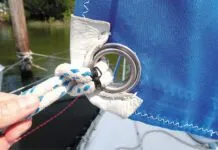Switch Failure
Is there a special way to keep bilge sump switches? The reason I am asking is that the Rule-A-Matics on my Hunter 34 seem to have a life span of about two seasons. Each fall at haul-out I drain the bilge sump so it is not subject to frost/freeze damage. But the switch float loses the desired tendency to rise on its own. The ability to make the electrical connection once the switch is elevated is intact. I reread your published review of bilge sump switches and did not find any specific care instructions, so I am assuming that these failures are just normal, but the frequency seems high.
Ronald Ingham
Warren, Michigan
If your Rule-A-Matic still makes electrical contact, then it has lasted longer than many. Over the years, we have received many failed Rule switches sent in by readers. The usual cause is water migration along the electrical wires, leading to corrosion. If the switch is not lifting easily, then perhaps there is either dirt or corrosion along the pivot, which can be cleaned.
In earlier articles, we have found the Ultra Jr. and Sr. to be the most failure-proof switch available. They are expensive, but all electrical components are above the water. West Marine sells them for $90 and $125. If you depend on a bilge pump switch, theyre worth the extra cost.
Keel Bolts
Ive been reading about your advice on crevice corrosion within stainless steel bolts attaching lead keels. Your suggestions for repair of corroded keel bolts indicate that the only workable solution is to replace the entire keel, because the original keel bolts are hot molded into the lead casting; retrofitting keel bolts wont provide sufficient strength.
Im wondering if my 20-year-old freshwater boat with lead keel is any safer from developing corrosion in the keel bolts? As a sailor on a budget, I shudder to think of replacing my entire keel.
I have a bilge that is typically wet; I have a traditional stuffing box and the ice box drains into the bilge. Is there anything you would recommend to stave off this problem?
Dan Leary
Neenah, Wisconsin
Because corrosion is much more of a problem in saltwater, we wouldnt worry much about keel bolts failing in freshwater. While a dry bilge is nice, often there isn’t much you can do about a wet one (thats why they make bilges!). That said, wed still pay attention to the keel/hull joint. Before launching each spring, check if there is a crack developing-usually there is. Caulk it and paint over it. Then go sailing and relax.
Hull Speed
Am I missing something? I thought the theoretical maximum hull speed for a displacement hull (sail or power) was calculated by the formula 1.34 times the square root of the waterline length.
In the review of the Sabre 362 it seemed you were suggesting a speed far in excess of that figure. Jim Taylor, the designer, gave a fair and honest estimate of the speed at approximately 7.3 knots (the calculation ends up being 7.39+ knots). As I understand that calculation, that is the theoretical maximum of the hull with no allowance for prop drag, any drag on the bottom, etc.
Your comment that the boat would easily top Taylors estimate of 7.3 knots isn’t supposed to be possible. Nor is the speed of 9 knots attributed to the boat by a satisfied owner. It takes a boat with a 45-foot waterline to achieve the latter speed! That is not to say the boat wont exceed that speed surfing on a wave face, but that isn’t what we normally consider sailing speed-or is it?
John Shugar
via e-mail
Yours is a good question. Actually, the formula for determining maximum hull speed is theoretical and only an approximation of top speeds. Steve Killings new book, Yacht Design Explained, has excellent drawings showing how the wave generated by a boats bow lengthens as boat speed increases. When it forms a one-wave cycle with the stern wave, the wave length is the same distance as the boats waterline. To make the boat go any faster, one needs to either add substantial power (such as a big engine), or find a way to keep the stern from squatting in the trough of the wavelength as the bow wave begins to stretch aft of the waterline. This can be achieved by either adding a bustle in the hullform just before the rudder or adding fullness aft to generate more buoyancy. When this is done, the boat can exceed its theoretical hull speed, usually on a reach. Or, as you point out, when surfing down a wave. Modern boats are getting flatter on the bottom, allowing them to more easily surf. Their downside is the tendency to pound upwind. For comfort, we still like a boat with a displacement/length ratio of, say, 225 or more.



































